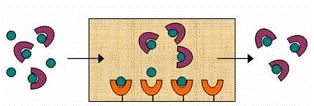Department of Chemistry
Document Type
Article
Date of this Version
2011
Citation
Anal. Methods, 2011, 3, 1449–1460. This archive contains the PubMed Central pdf version
Abstract
The binding of drugs with serum proteins and binding agents such as human serum albumin, a1-acid glycoprotein, and lipoproteins is an important process in determining the activity and fate of many pharmaceuticals in the body. A variety of techniques have been used to study drug interactions with serum proteins, but there is still a need for faster or better methods for such work. High-performance liquid chromatography (HPLC) is one tool that has been utilized in many formats for these types of measurements. Advantages of using HPLC for this application include its speed and precision, its ability to be automated, its good limits of detection, and its compatibility with a wide range of assay formats and detectors. This review will discuss various approaches in which HPLC can be employed for the study of drug-protein interactions. These techniques include the use of soluble proteins in zonal elution and frontal analysis methods or vacancy techniques such as the Hummel-Dreyer method. Zonal elution and frontal analysis methods that make use of immobilized proteins and high-performance affinity chromatography will also be presented. A variety of applications will be examined, ranging from the determination of free drug fractions to the measurement of the strength or rate of a drugprotein interaction. Newer developments that will be discussed include recent work in the creation of novel mathematical approaches for HPLC studies of drug-protein binding, the use of HPLC methods for the high-throughput screening of drug-protein binding, and the creation and use of affinity monoliths or affinity microcolumns for examining drug-protein systems.



Comments
Copyright The Royal Society of Chemistry 2011 & Used by permission.